High-Isolation Six-Port MIMO Antenna for 24 GHz Radar Featuring Metamaterial-Based Decoupling
Abstract
1. Introduction
- The introduction of an optimized MTM-based decoupling mechanism that achieves exceptional inter-port isolation exceeding 46 dB in a compact six-port configuration.
- The demonstration of a high peak gain of 17.4 dBi alongside a significantly suppressed side lobe level of −24.6 dB, metrics that are critical for long-range detection and target discrimination.
- A comprehensive performance evaluation showing that the proposed design surpasses many existing solutions, validating it as a robust and promising candidate for next-generation short-range radar and sensing applications.
2. Materials and Methods
2.1. Antenna Array Design and Synthesis
2.2. Physical Implementation and Feeding Network
2.3. MIMO Configuration and Metamaterial Integration
3. Results and Discussion
3.1. Antenna Geometry and Configuration
3.2. Metamaterial Unit Cell: Design and Electromagnetic Characterization
3.3. MIMO Performance Evaluation
3.4. Antenna Gain Performance
3.5. MIMO Diversity Performance Evaluation
3.6. Radiation Pattern Analysis
3.7. Experimental Results
3.8. Performance Benchmarking and Discussion
4. Conclusions
Author Contributions
Funding
Data Availability Statement
Acknowledgments
Conflicts of Interest
References
- Issakov, V. Microwave Circuits for 24 GHz Automotive Radar in Silicon-Based Technologies; Springer Science & Business Media: Berlin/Heidelberg, Germany, 2010. [Google Scholar]
- Waldschmidt, C.; Hasch, J.; Menzel, W. Automotive radar—From first efforts to future systems. IEEE J. Microw. 2021, 1, 135–148. [Google Scholar] [CrossRef]
- Arai, T.; Usugi, T.; Murakami, T.; Kishimoto, S.; Utagawa, Y.; Kohtani, M.; Ando, I.; Matsunaga, K.; Arai, C.; Yamaura, S. A 77-GHz 8RX3TX transceiver for 250-m long-range automotive radar in 40-nm CMOS technology. IEEE J. Solid-State Circuits 2021, 56, 1332–1344. [Google Scholar] [CrossRef]
- Hasch, J.; Topak, E.; Schnabel, R.; Zwick, T.; Weigel, R.; Waldschmidt, C. Millimeter-wave technology for automotive radar sensors in the 77 GHz frequency band. IEEE Trans. Microw. Theory Tech. 2012, 60, 845–860. [Google Scholar] [CrossRef]
- Schneider, M. Automotive radar-status and trends. In Proceedings of the German Microwave Conference, Ulm, Germany, 5–7 April 2005; pp. 144–147. [Google Scholar]
- Wang, S.; Wang, W.; Zheng, Y. Dual-Functional Quasi-Uniform Beam-Scanning Antenna Array with Endfire Radiation Capability for Integrated Sensing and Communication Applications. IEEE Trans. Veh. Technol. 2025, 74, 17829–17839. [Google Scholar] [CrossRef]
- Hamdan, S.; Hamad, E.K.; Mohamed, H.A.; Khaleel, S.A. High-performance MTM inspired two-port MIMO antenna structure for 5G/IoT applications. J. Electr. Eng. 2024, 75, 214–223. [Google Scholar] [CrossRef]
- Sharma, P.; Tiwari, R.N.; Singh, P.; Kumar, P.; Kanaujia, B.K. MIMO antennas: Design approaches, techniques and applications. Sensors 2022, 22, 7813. [Google Scholar] [CrossRef]
- Shaban, M. Design and Modeling of a Reconfigurable Multiple Input, Multiple Output Antenna for 24 GHz Radar Sensors. Modelling 2025, 6, 2. [Google Scholar] [CrossRef]
- Gennarelli, G.; Noviello, C.; Ludeno, G.; Esposito, G.; Soldovieri, F.; Catapano, I. 24 GHz FMCW MIMO radar for marine target localization: A feasibility study. IEEE Access 2022, 10, 68240–68256. [Google Scholar] [CrossRef]
- Khan, M.I.; Khan, M.K.; Rahman, S.U.; Anab, M.; Basit, A. Quad ports millimeter-wave MIMO antenna with parasitic element and defected ground structure for radar sensing application. Radio Sci. 2025, 60, 1–12. [Google Scholar] [CrossRef]
- Xu, J.; Wang, Y. A Defected Ground Structure Design for Reducing Coupling in Dual-Band MIMO Antennas. Prog. Electromagn. Res. C 2025, 158, 93–101. [Google Scholar]
- Acharjee, J.; Uzair, M.; Phakaew, T.; Kaewcharoen, A.; Ali, J.; Mandal, K.; Akkaraekthalin, P.; Chalermwisutkul, S. Dual-Broadband Metasurface Printed on Mobile Phone Back Cover for Enhanced Antenna Performance and SAR Reduction. Wirel. Pers. Commun. 2025, 142, 185–212. [Google Scholar] [CrossRef]
- Mantri, P.; Srivastava, P.; Jana, B.; Ranjan, P. Dual-Port Metamaterial-Based Mirror-Inverted MIMO Antenna for 5G Millimeter-Wave Applications. Int. J. Commun. Syst. 2025, 38, e70164. [Google Scholar] [CrossRef]
- Cheribi, H.; Azrar, A.; Bouaraba, A.; Benmahmoud, F. High isolation metamaterial based MIMO antenna with modified ground for 5G millimeter-wave applications. Frequenz 2025, 79, 653–661. [Google Scholar] [CrossRef]
- Babu, N.S.; Kumar, S.; Ansari, A.Q.; Kanaujia, B.K.; Goyal, B.; Altameem, T.; El-Shafai, W. High-Gain 16-Port mm-Wave MIMO Antenna With Spiral-Shaped Electromagnetic Band Gap for 5G Applications. Int. J. Commun. Syst. 2025, 38, e70074. [Google Scholar] [CrossRef]
- Alibakhshikenari, M.; Virdee, B.S.; Shukla, P.; See, C.H.; Abd-Alhameed, R.A.; Falcone, F.; Quazzane, K.; Limiti, E. Isolation enhancement of densely packed array antennas with periodic MTM-photonic bandgap for SAR and MIMO systems. IET Microw. Antennas Propag. 2020, 14, 183–188. [Google Scholar] [CrossRef]
- Khan, A.A.; Wang, Z.; Li, D.; Aburas, A.; Ahmed, A.; Aburas, A. Metamaterial-Enhanced MIMO Antenna for Multi-Operator ORAN Indoor Base Stations in 5G Sub-6 GHz Band. Appl. Sci. 2025, 15, 7406. [Google Scholar] [CrossRef]
- Khaleel, S.A.; Hamad, E.K.; Parchin, N.O.; Saleh, M.B. Programmable beam-steering capabilities based on graphene plasmonic THz MIMO antenna via reconfigurable intelligent surfaces (RIS) for IoT applications. Electronics 2022, 12, 164. [Google Scholar] [CrossRef]
- Di, B.; Zhang, H.; Han, Z.; Zhang, R.; Song, L. Reconfigurable holographic surface: A new paradigm for ultra-massive MIMO. IEEE Trans. Cogn. Commun. Netw. 2025. early access. [Google Scholar] [CrossRef]
- Li, G.; Ge, Y.; Zhou, Z.; Zhang, Z.; Chen, Z. 2-Bit Electrically Reconfigurable Reflectarray With Multi-Polarization Capability. IEEE Access 2025, 13, 158832–158842. [Google Scholar] [CrossRef]
- Wang, Y.; Xue, Q.; Wan, Y. Element-level Polarization-Switchable Beamforming Empowering 3-Stage Phased Array Antennas. IEEE Trans. Antennas Propag. 2025, 73, 3680–3691. [Google Scholar] [CrossRef]
- Balanis, C.A. Antenna Theory: Analysis and Design; John Wiley & Sons: Hoboken, NJ, USA, 2005. [Google Scholar]
- Orfanidis, S.J. Electromagnetic Waves and Antennas; Rutgers University: New Brunswick, NJ, USA, 2002. [Google Scholar]
- Milligan, T.A. Modern Antenna Design; John Wiley & Sons: Hoboken, NJ, USA, 2005. [Google Scholar]
- Yang, W.; Yang, Y.; Che, W.; Gu, L.; Li, X. A novel 24-GHz series-fed patch antenna array for radar system. In Proceedings of the 2016 IEEE International Workshop on Electromagnetics: Applications and Student Innovation Competition (iWEM), Nanjing, China, 16–18 May 2016; pp. 1–4. [Google Scholar]
- Sharma, M.; Gautam, A.K.; Agrawal, N.; Singh, N. Design of MIMO planar antenna at 24 GHz band for radar, communication and sensors applications. AEU-Int. J. Electron. Commun. 2021, 136, 153747. [Google Scholar] [CrossRef]
- Kim, S.; Kim, D.K.; Kim, Y.; Choi, J.; Jung, K.Y. A 24 GHz ISM-band Doppler radar antenna with high isolation characteristics for moving target sensing applications. IEEE Antennas Wirel. Propag. Lett. 2019, 18, 1532–1536. [Google Scholar] [CrossRef]
- Sharma, A.; Santanu, D.; Binod, K.K.; Deepak, G.; Sachin, K.; Satya, P.S.; Aime, L.E. In-band RCS reduction and isolation enhancement of a 24 GHz radar antenna using metamaterial absorber for sensing and automotive radar applications. IEEE Sens. J. 2020, 20, 13086–13093. [Google Scholar] [CrossRef]
- Mukherjee, A.; Sarkar, D. Interleaved MIMO Radar for Marine Target Tracking Application. In Proceedings of the 2024 4th URSI Atlantic Radio Science Meeting (AT-RASC), Meloneras, Spain, 19–24 May 2024; pp. 1–4. [Google Scholar]
- Musaed, A.A.; Al-Bawri, S.S.; Abdulkawi, W.M.; Aljaloud, K.; Yusoff, Z.; Islam, M.T. High isolation 16-port massive MIMO antenna based negative index metamaterial for 5G mm-wave applications. Sci. Rep. 2024, 14, 290. [Google Scholar] [CrossRef] [PubMed]




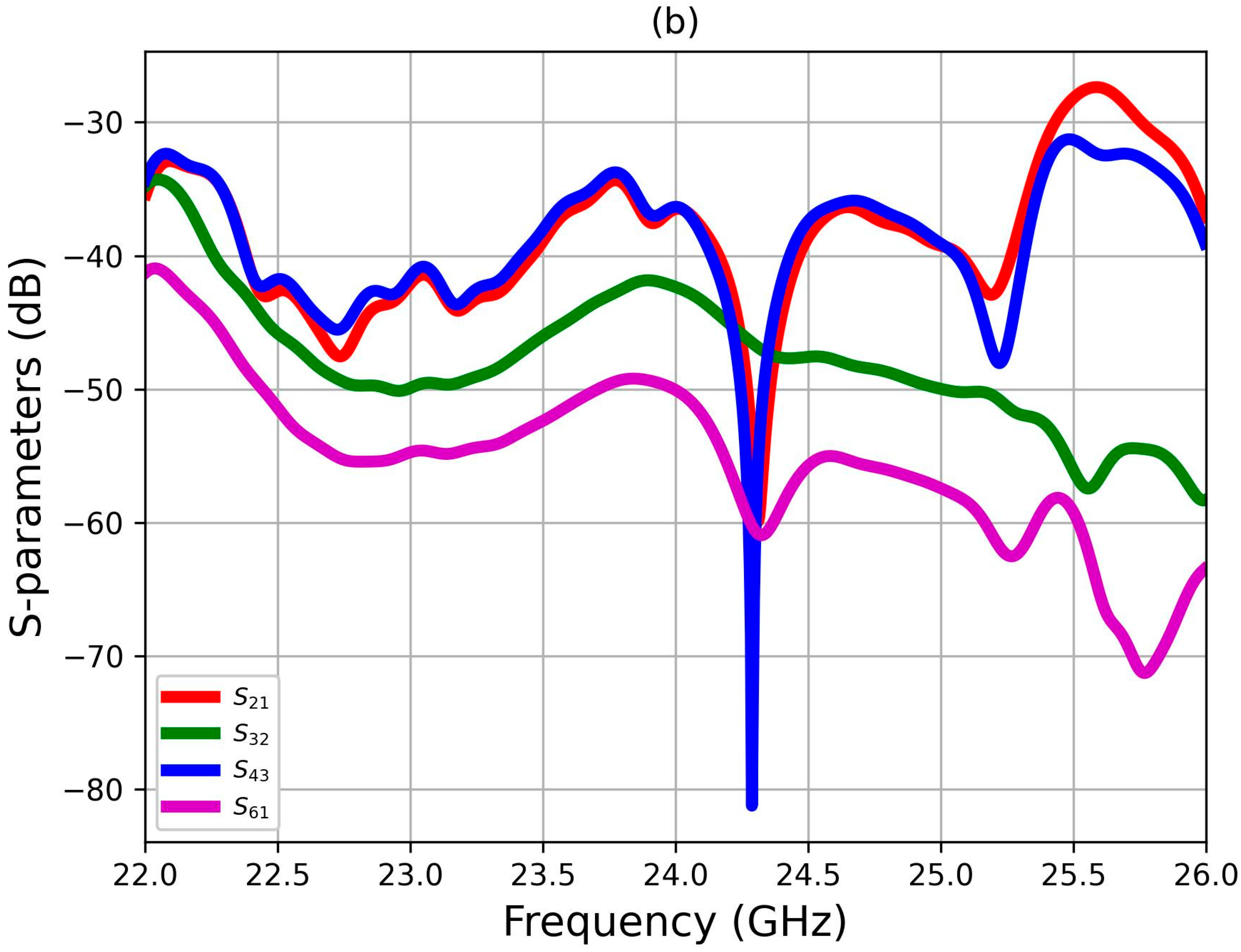

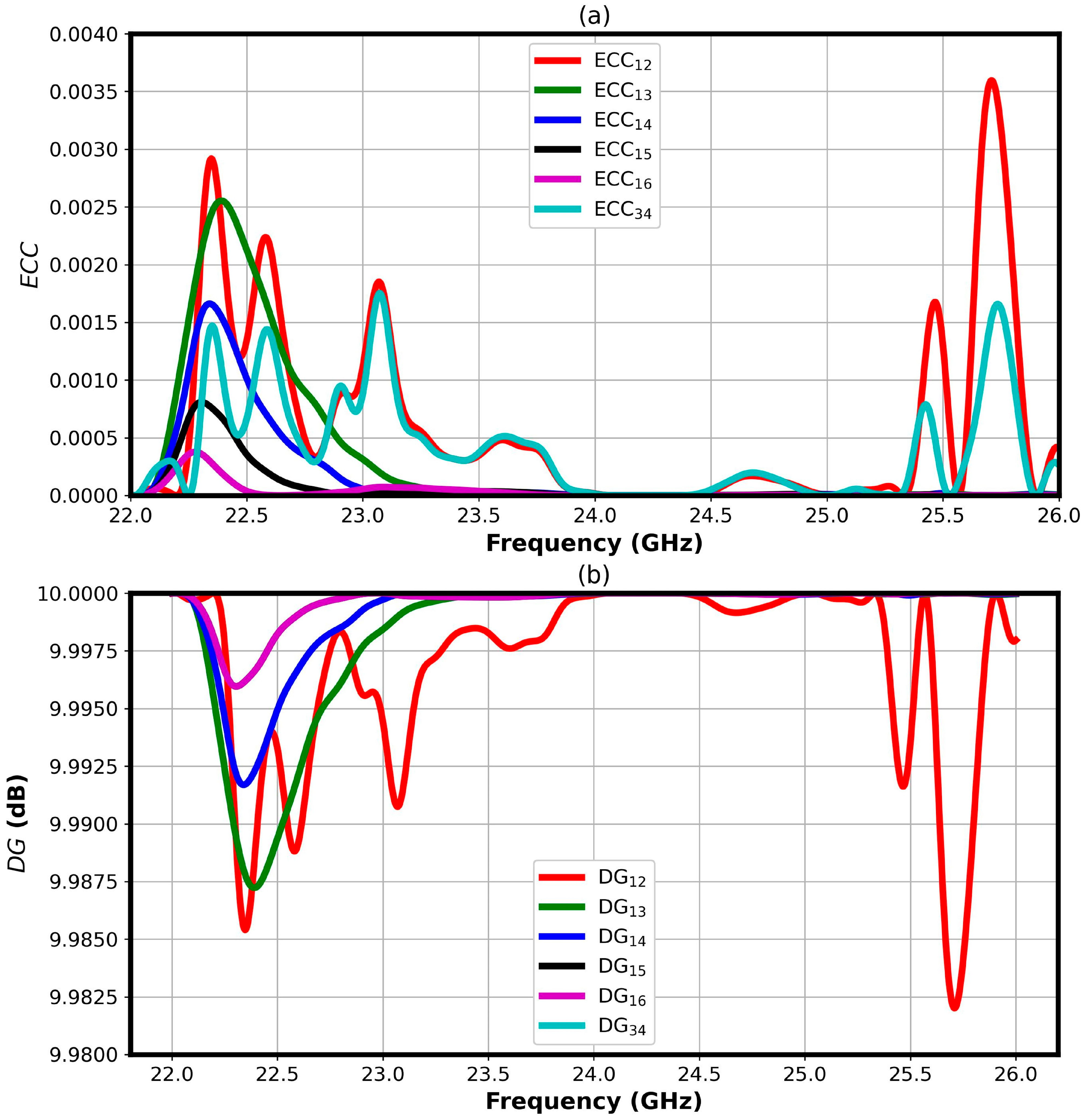

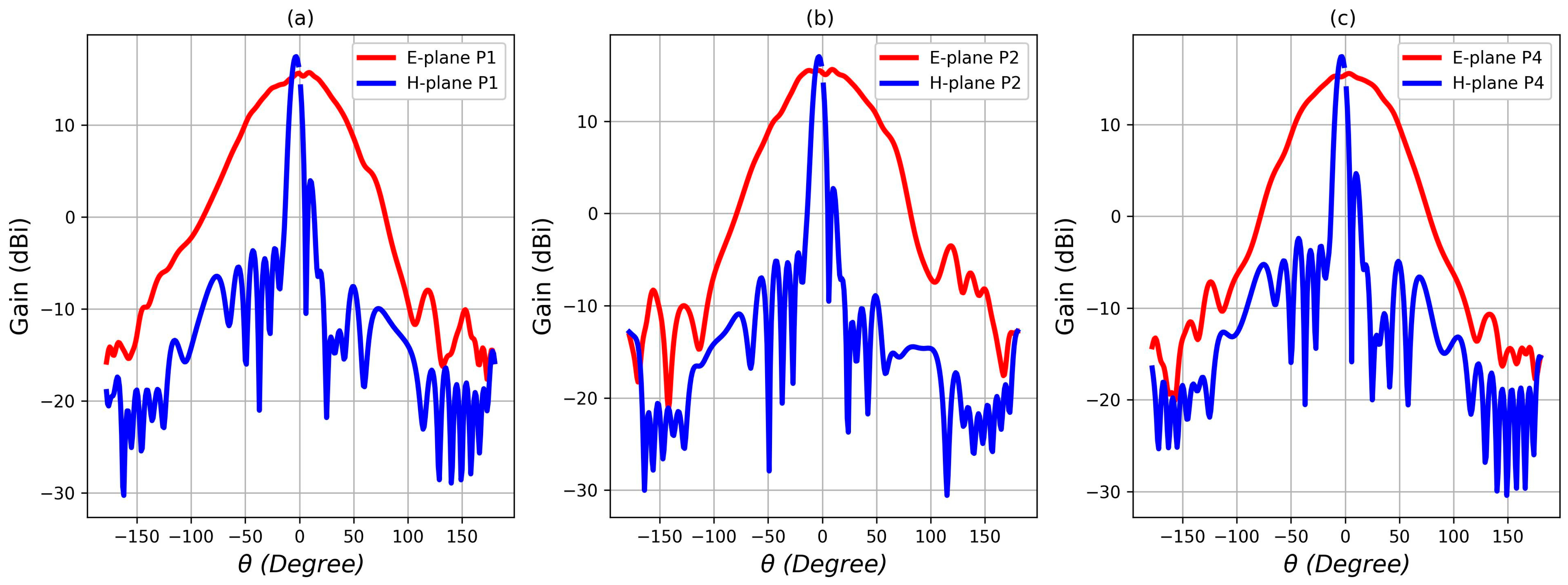

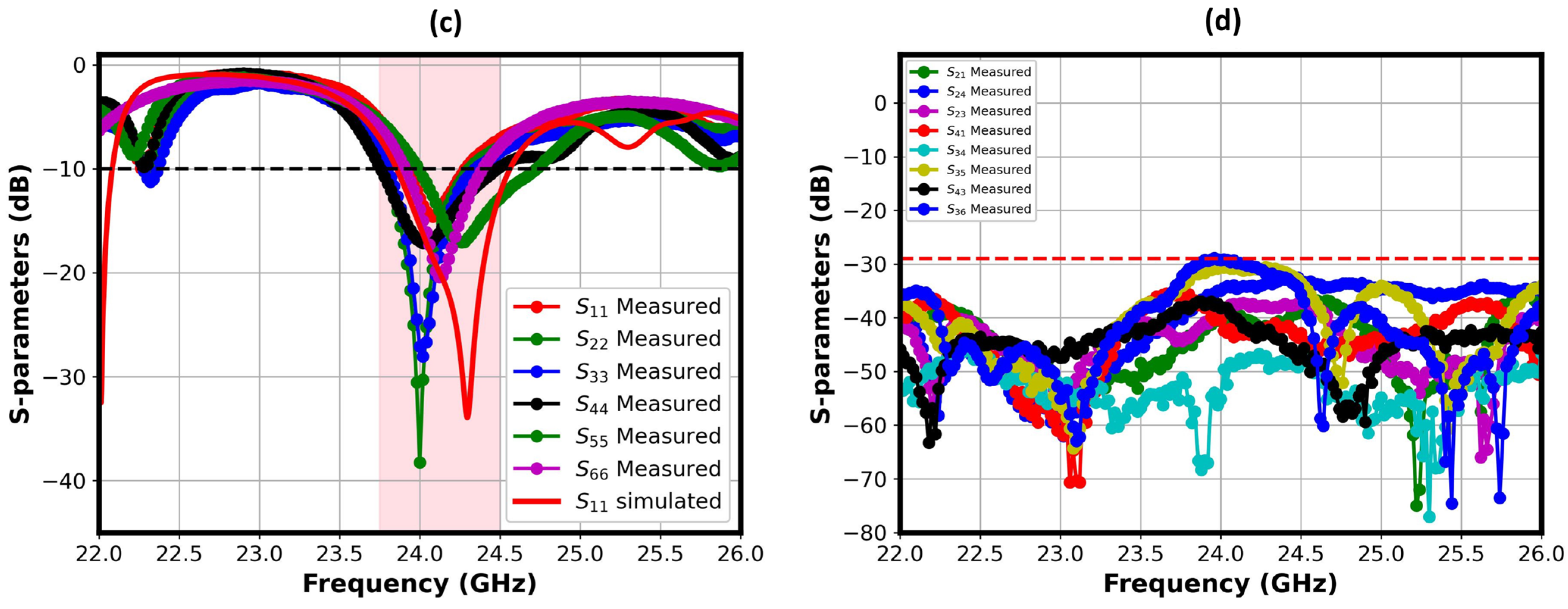
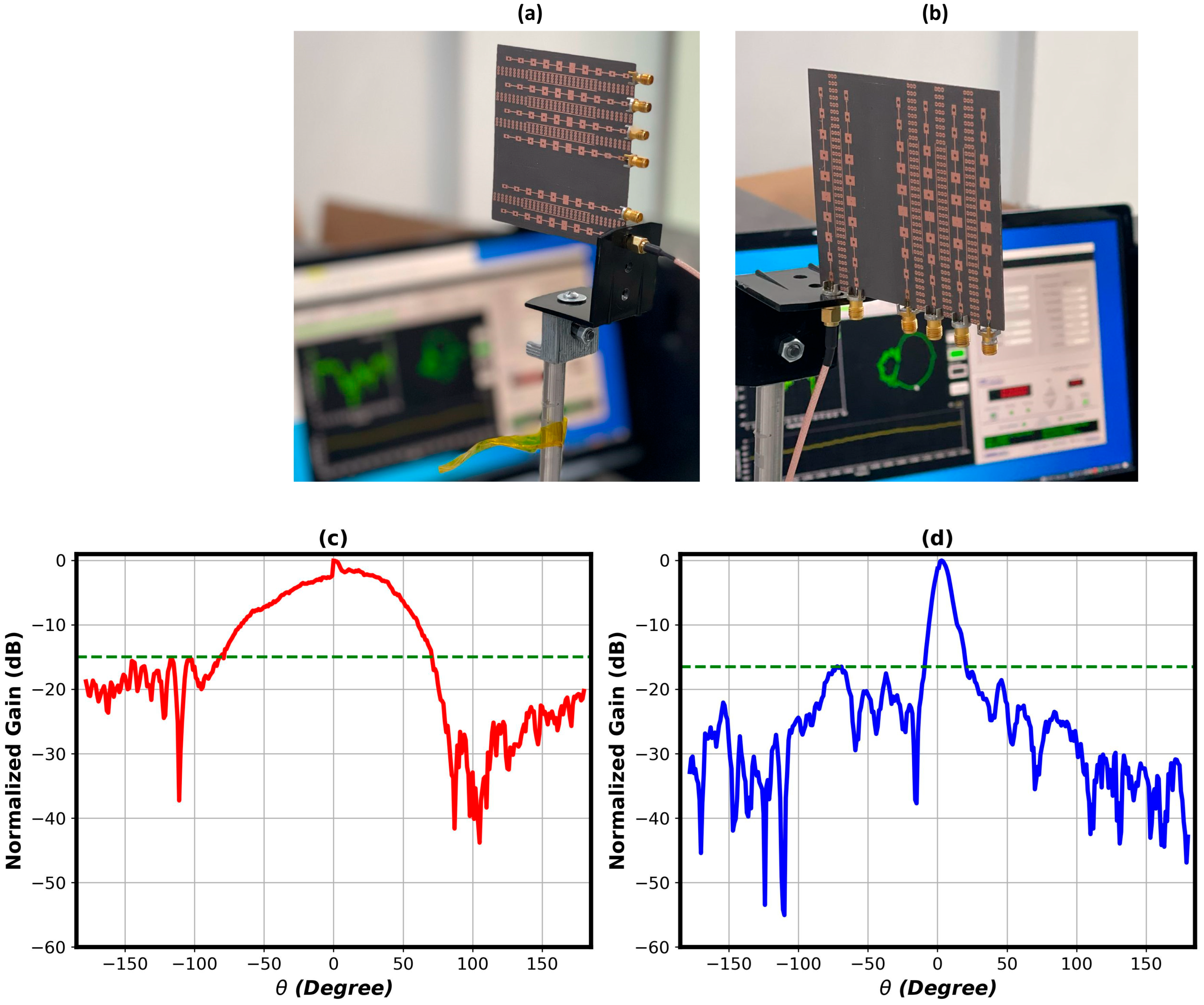
| SLL (dB) | Simulated | Measured |
|---|---|---|
| E-plane | −24.6 | −15.0 |
| H-plane | −15.8 | −16.5 |
| Reference No. | Operating Frequency (GHz) | Substrate | No. of MIMO Ports | Array Elements | Dimensions (mm2) | Bandwidth (GHz) | Gain (dBi) | Isolation (dB) | SLL (dB) |
|---|---|---|---|---|---|---|---|---|---|
| [28] | 24.0 | Rogers 4350B (Chandler, AZ, USA) | 2 | 2 × 2 | 58 × 55 | 0.51 | 5.2 | 36.7 | NA |
| [26] | 24.5 | Rogers 4350 | 1 | 8 × 8 | 40 × 6 | 2.0 | 20.6 | NA | −20 |
| [29] | 24.0 | Rogers 4350B | 2 | 2 × 2 | 36 × 22 | 1.0 | 12.5 | 34 | −15 |
| [27] | 24.0 | RT-Duroid 5880 (Rogers, Chandler, AZ, USA) | 2 | 2 × 2 | 40 × 06 | 4.44 | 9.8 | 45 | NA |
| [30] | 24.0 | RT-Duroid 5880 | 6 | 1 × 7 | 105.5 × 56.6 | 0.15 | 13.7 | 17 | −11 |
| [31] | 28.0 | RT-Duroid 5880 | 16 | 16 × 4 | 30 × 200 | 3.5 | 19.9 | 25 | NA |
| This work | 24.3 | RT/Duroid 5880 | 6 | 1 × 10 | 98 × 90 | 0.71 | 17.4 | 46.7 | −24.6 (E-plane) −15.8 (H-plane) |
Disclaimer/Publisher’s Note: The statements, opinions and data contained in all publications are solely those of the individual author(s) and contributor(s) and not of MDPI and/or the editor(s). MDPI and/or the editor(s) disclaim responsibility for any injury to people or property resulting from any ideas, methods, instructions or products referred to in the content. |
© 2025 by the authors. Licensee MDPI, Basel, Switzerland. This article is an open access article distributed under the terms and conditions of the Creative Commons Attribution (CC BY) license (https://creativecommons.org/licenses/by/4.0/).
Share and Cite
Shaban, M.; Alsaab, N.; Alhassoon, K.; Alsaleem, F.; Alsunaydih, F.N.; Alwatban, F.; Almushaiti, N.; Alnogithan, A.; Alsalman, A. High-Isolation Six-Port MIMO Antenna for 24 GHz Radar Featuring Metamaterial-Based Decoupling. Electronics 2025, 14, 4612. https://doi.org/10.3390/electronics14234612
Shaban M, Alsaab N, Alhassoon K, Alsaleem F, Alsunaydih FN, Alwatban F, Almushaiti N, Alnogithan A, Alsalman A. High-Isolation Six-Port MIMO Antenna for 24 GHz Radar Featuring Metamaterial-Based Decoupling. Electronics. 2025; 14(23):4612. https://doi.org/10.3390/electronics14234612
Chicago/Turabian StyleShaban, Mahmoud, Nabeel Alsaab, Khaled Alhassoon, Fahd Alsaleem, Fahad Nasser Alsunaydih, Faisal Alwatban, Nawaf Almushaiti, Abdulaziz Alnogithan, and Abdulelah Alsalman. 2025. "High-Isolation Six-Port MIMO Antenna for 24 GHz Radar Featuring Metamaterial-Based Decoupling" Electronics 14, no. 23: 4612. https://doi.org/10.3390/electronics14234612
APA StyleShaban, M., Alsaab, N., Alhassoon, K., Alsaleem, F., Alsunaydih, F. N., Alwatban, F., Almushaiti, N., Alnogithan, A., & Alsalman, A. (2025). High-Isolation Six-Port MIMO Antenna for 24 GHz Radar Featuring Metamaterial-Based Decoupling. Electronics, 14(23), 4612. https://doi.org/10.3390/electronics14234612







